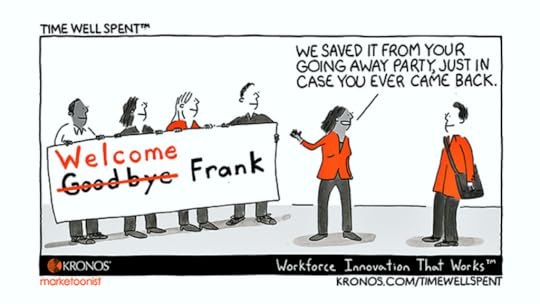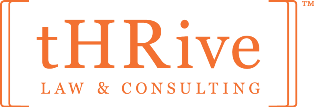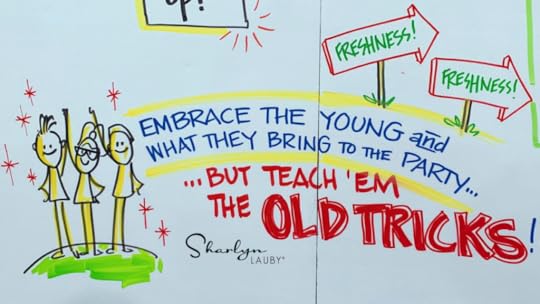Sharlyn J. Lauby's Blog, page 93
September 6, 2019
Bookmark This! Caregiving Edition

According to the Family Caregiver Alliance, approximately 43.5 million caregivers have provided unpaid care to an adult or child. On average, they spend about 13 days each month doing tasks like shopping, food preparation, housekeeping, laundry, and transportation.
Organizations need to be aware that these millions of caregivers include their employees. And that these activities have an impact on employee well-being. Even when you love the person who you’re providing care for, it’s still hard both emotionally and financially.
Keep in mind that caregiving isn’t exclusive to family members. Many employees have a person in their lives who was like a second parent that’s not a blood relative. They might have an aunt, uncle, or grandparent who played a significant role in their lives. Those individuals are like family and, in some cases, might be more important than a person who fits our company definition of “close relative”. It’s important for organizations to think about what the definition of family is going to be and consider if it’s time to expand that definition to meet today’s modern family.
One of the biggest steps that organizations can take toward helping caregiving employees is providing information. Recently, I was listening in on a webinar hosted by AARP about the subject of caregiving and 75% of listeners did not know if caregiving benefits were available to them. And even if your organization doesn’t offer something specifically labeled “caregiving benefit”, is it possible that there are benefits that caregivers can take advantage of like paid time off (PTO) or employee assistance programs (EAP).
That’s why I wanted to put this list together. If you have employees who might be looking for resources, here are some places that they can get caregiver information.
AARP Caregiving webpage includes medical, legal, and financial information along with caregiving stories that could provide some additional support. AARP also has a caregiving app (FREE on iTunes) and a caregiving support line.
AARP Prepare to Care: A Caregiving Planning Guide for Families has information on how to assess the needs of a loved one, have vital conversations about care, and locate helpful resources. These are available in a variety of languages and specific focuses like LGBTQ and veterans.
Organizations can refer to the Employer Caregiving Toolkit from the Northeast Business Group on Health to get some ideas of things they can do beyond providing employees a list of resources. Or think about starting an employee affinity group for caregivers.
AARP and ReACT worked together to create a white paper for employers titled “Determining the Return on Investment: Supportive Policies for Employee Caregivers”. I learned about this resource a couple of years ago at a Society for Human Resource Management (SHRM) event.
It’s no surprise that people are aging. That’s a fact of life. Organizations need to demonstrate that they are aware of the challenges associated with caregiving. Not only will it make employee’s lives better, but it will help their work performance which benefits the organization.
Image captured by Sharlyn Lauby at the 34th Street Graffiti Wall in Gainesville, FL
The post Bookmark This! Caregiving Edition appeared first on hr bartender.






September 5, 2019
Media Literacy Is a Business Competency

Regardless of your politics, we’ve all been
exposed to the notion of “fake news”.
It might have been someone who shared an announcement that a celebrity has
died, only to find out that it’s either not true or it happened four years ago.
Or a news agency that labels an act of violence as terrorism (or completely
dismisses it) before all the facts are in. Bottom-line: as much as technology
and social media have brought value, those tools have also created challenges.
So, each of us has been susceptible to
misinformation on the internet and my guess is that it won’t be the last time.
This is our new normal and not something to be ashamed or embarrassed about.
Even professional journalists have experienced it. And the answer isn’t to stop
using the internet. It’s to get better about questioning what we read and see.
I recently discovered a course called CrashCourse Media
Literacy which is a 12-series YouTube program that
focuses on how to consume and evaluate the media. It might be tempting to think
that if you use the internet a lot you already know everything there is to
know. After watching the CrashCourse Media Literacy program, I would strongly
recommend this course to anyone wanting stay grounded and learn more about how
the internet shapes our lives.
The episodes are educational, informative, and
sometimes funny. None of the episodes are longer than 10-minutes. I’d like to
think that we can all afford to take 10-minutes a day to learn more about the
internet. And I’m not just talking about “fake news”. The program does a
good job of defining what media is and how we need to think of it as more than
social media platforms like Facebook
or Instagram. I had several takeaways from this series
that I believe will help me be a better media consumer.
Media literacy isn’t only about what we share.
Yes,
it’s important that we share only legitimate news.
But it’s also important that we don’t assume the all the news we receive is
always 100% complete. It’s possible that we’re only hearing a small portion of
the news or the facts. And it’s our obligation as a media consumer to research
the whole story. We can’t make informed decisions with a fraction of the facts.
Granted, there might be times when we don’t get all the facts and we’ll have to
decide what to do with that scenario as well. But sometimes, we can find more
information if we go looking for it.
It’s important to understand what happens with
your data. I’m not anti-marketing. I think it’s
fantastic that marketing companies have access to consumer data that helps them
make good business decisions. That being said, as consumers, we need to know
what data we’re sharing with companies and what they have permission to do with
it. I must admit that I was surprised the CrashCourse program included a
section on user data, targeting ads, and terms of service agreements. It
reminded me that part of my responsibility as a media consumer is understanding
what happens with my data.
Media consumers might find it helpful to
understand the business of media. Another aspect
of the program that I thought was interesting was the conversation about who
owns what media and how media ownership can impact what information we see (or
don’t see). The program also spent some time talking about which media entities
are regulated by the government, which ones aren’t, and why we might want to
know that information. Finally, it discussed about how media companies create
strategic partnerships with the businesses that make our phones, computers, and
televisions to form bundles and exclusive agreements, which may or may not
benefit consumers.
Now, the purpose of this article isn’t to
scare anyone. It’s not to imply that anyone should close all their social media
accounts. And it’s certainly not to say that marketing and media companies are
doing anything wrong. The purpose of today’s article is to encourage people to
become more aware of their relationship with media. The more aware we are about
media, the more internet literate we can become.
As business people, we spend a lot of time on
the internet. We use articles and reports from the internet in our
presentations and proposals. We
share content on our social media accounts. We
comment on what people write on their blogs, etc. It’s important that we’re
responsible media publishers which means as individuals, we must learn how to
be media literate.
The post Media Literacy Is a Business Competency appeared first on hr bartender.






September 3, 2019
HR Technology: 13 Concepts HR Pros Needs to Know

It’s no secret. I love technology. In our small business, we
rely on technology to extend our capabilities and provide an agile response to
customer needs. That helps us remain competitive. But the more I learn about
technology, I realize there’s still a lot to learn.
On some level, technology reminds me of the reason I entered
the human resources profession. It’s always changing and evolving. It’s always
getting better. Since technology is moving at such a rapid pace, it can be a
challenge to keep up with all the terms and acronyms. That’s one of the reasons
I started this “Everything HR Needs to Know … “ series on HR Bartender. These
articles are designed to help us quickly understand the technology and its
business implications.
I also realize that I’ve done quite a few of these articles.
If you haven’t checked them out lately, here’s a list of the top 12 technology concepts
you should probably know.
Artificial
Intelligence (AI) – It’s become a part of today’s HR world. But what is Artificial
Intelligence (AI) and how can it benefit us? Experts help us understand how to
use it.Blockchain
– Like a lot of technology, blockchain has strong benefits if used properly.
Learn more about why HR needs to pay attention to this new technology.Chatbots
– It should be no surprise that bots are becoming a part of HR. They’re being
used in recruiting, onboarding, and employee engagement.Cloud
Computing – The cloud (aka cloud computing) is permeating almost every
aspect of HR technology. We asked our friends at Kronos to tell us everything
we need to know.Digital
Transformation – Digital transformation is all about changing the
workplace. Paycom shows us HR needs to embrace the strategic advantages
technology brings.Enterprise
Resource Planning (ERP) – Brian Sommer from TechVentive shares with us what
an ERP is and how it compares to a human resource management system (HRMS). Experience
Management (XM) – Our friends at Qualtrics XM shows how experience management
(XM) uses experience and operational data to measure and improve business
initiatives. Human
Capital Management (HCM) – Bill Kutik, Human Resource Executive
technology columnist, shares everything HR needs to know about the growing –
and pretty confusing – field of human capital management. Internet
of Things (IoT) – The latest technology term for HR pros is the Internet of
Things – or IoT. It’s all about connectivity but it’s much more than that.Machine
Learning – Machine learning is quickly becoming an important data tool for
HR professionals. But, what is it and how does it differ from artificial
intelligence (AI)?Prescriptive
Analytics – Technology can help HR be more effective. One example is
prescriptive analytics. O.C. Tanner shows us how prescriptive analytics works
for HR.Software-as-a-Service
(SaaS) – SaaS – software as a service – is a term we’ve all heard before.
But what is it exactly? The experts at HR Direct tell everything to know about
SaaS.User
Experience (UX) – HR pros don’t need to build software, but they do need to
know about the software user experience (UX). Ultimate Software’s Martin
Hartshorne tells us everything HR needs to know.
Human resources technologies have the ability to make our
departments run more effectively and efficiently. We can use our time building
relationships and finding the best talent for the organization.
Speaking of using HR Technology to benefit the business, it’s not too late to attend the 2019 HR Technology Conference and Expo, which will be held October 1 – 4, 2019 in Las Vegas. You can save $300 off registration with the promotion code HRBAR19. This event is on my “must” attend list. I always leave with a long list of takeaways. Hopefully you can join us.
Image captured by Sharlyn Lauby while exploring the Wynwood District in Miami, FL
The post HR Technology: 13 Concepts HR Pros Needs to Know appeared first on hr bartender.






August 30, 2019
Welcome Boomerang Employees Back in Style

(Editor’s Note: Today’s article is brought to you
by
our friends at Kronos
,
a leading provider of workforce management and human capital management cloud solutions.
Both Fortune Magazine and the Great Place to Work Institute have named Kronos
a
best workplace for Millennials for a second year in a row
.
Congratulations to them! Enjoy the article.)
I recently had the opportunity to interview Kronos CEO Aron
Ain about his book, “WorkInspired:
Build an Organization Where Everyone Loves to Work” and his journey of
transforming the company into a billion dollar business. I hope you’ll take the
time to check out the webcast because I really enjoyed the conversation.
In discussing the culture of Kronos with Ain, one of the
things he likes to talk about are boomerang employees. He’s very open about
letting employees spread their wings and listen to other opportunities. He’s
also comfortable with the Kronos culture and work environment to let exiting
employees know that they’re welcome back at any time.
This isn’t something new at Kronos. I’ve been working with the company for years and this has always been a part of who they are. I know many organizations are apprehensive about rehiring employees. And only because of the challenges in today’s labor market are they reconsidering that point-of-view.
But today’s Time Well Spent cartoon reminded me of the
conversations I’ve had with Ain and Joyce
Maroney, executive director at The Workforce Institute, about Kronos’ views
on boomerang employees. In fact, did you know that Kronos
promotes the boomerang trend on their website? And while your organization
might not want to dedicate a page to boomerang employees, does your company
include anywhere in their recruitment marketing that they encourage former
employees to reapply?
The other thing that today’s Time Well Spent reminded
me of is that we need to make orientation and onboarding more of a celebration.
Often when employees leave, the company or the employee’s department throws
them a nice party or takes the departing employee out to lunch. Sometimes the
exiting employee is given a gift. Do new employees get the same? It would send
a huge message if new hires got the same gifts and parties that exiting
employees do. Just something to think about.
A lot of great employees leave our companies for no fault of
the organization. And sometimes they regret those decisions. Organizations have
the opportunity to leave the door open. The question becomes, will they do it.
The post Welcome Boomerang Employees Back in Style appeared first on hr bartender.






August 27, 2019
Everything #HR Needs to Know About Digital Transformation

(Editor’s Note: Today’s article is brought to you by our friends at Paycom , a leading provider of cloud-based human capital management software. They recently announced the release of Ask Here TM , a new tool that gives employees a direct line of communication to ask and get timely answers to work-related questions. Enjoy the article!)
Technology is a huge part of today’s business environment.
As such, it’s becoming a big part of human resources. And we’re not simply
talking about a new piece of software or hardware. Human resources
professionals have to think differently about the role technology plays in the
business as well as the human resources function.
During the Society for Human Resource Management (SHRM)
annual conference, I had the pleasure to spend some time with Jennifer Kraszewski,
vice president of human resources at Paycom. We talked about how technology
is transforming human resources. It was a terrific conversation, so I asked
Jennifer if she would share her thoughts here on HR Bartender as well.
Thankfully, she said “yes”.
Jennifer, we read and
hear a lot about the term “digital transformation.” Can you briefly describe
what it means?
[Kraszewski] The digital transformation is about more than
just technology. It’s about how technology simplifies the way we do things, and
changes how we think about what’s possible. We’ve seen evidence of this in our
own lives. We use apps to easily complete what used to be time-consuming,
mundane tasks, like personal banking and grocery shopping.
Technology has so simplified the way we generally go about
our days, it has become the backbone of modern life that frees us to pursue more
meaningful goals, both personal and professional.
Why should human
resources departments focus on digital transformation?

[Kraszewski] When it comes to the workplace, this pace of transformation
is behind the rest of the organization. Nowhere is this truer than in the HR
department. Despite the flourish of human capital management (HCM) technology
vendors that have emerged, many HR departments remain mired in manual processes.
Why? Because technology alone is not the answer.
The key to utilizing technology in HR is being open and prepared for changing and simplifying processes that will have a positive impact on organizational culture. For example, by allowing employees to complete their own HR-related tasks with one easy-to-use app, HR is freed from antiquated processes and administrative tasks, so it can focus on high-level initiatives that drive the business forward.
You mentioned giving
employees the ability to complete their own HR-related tasks. Can you share
with readers an example of how employee self-service can digitally transform
the workplace?
[Kraszewski] Late last year, Ernst & Young did a study
that found the cost of data input for HR-related information is $4.39, per data
point. With Paycom’s Direct
Data Exchange, the industry’s first tool of its kind, our clients can pull
employee usage data showing how many entries employees have made for themselves
versus made by HR or their manager on their behalf.
Let’s say the company can see 11,000 data entries or changes made
by the employee, but 72,000 made by the employer that could have been made by
the employee, then there is significant return-on-investment (ROI) available
for the employer: nearly $320,000 simply by having the employee enter the data
or make the change.
Once employers and HR change their mindset to empower their
employees to enter information, self-service technology will truly digitally
transform HR functions within an organization.
What challenges do
you see for organizations considering a digital transformation?
[Kraszewski] Some HR departments remain concerned about
technology eliminating their jobs. We must be careful to not appear as if we
are ‘going around’ the HR person. If HR does not buy into the employee usage
strategy, real change will not occur, and the employees will not have control
over their own data. As a result, the organization will continue to have
antiquated HR processes that prevent them from having a more strategic HR
vision.
Most people who became HR practitioners did so because they
wanted to help people. It’s important the employee-focused message feels
inclusive to HR. Our approach should focus on how HCM technology actually allows
us to be more strategic in our roles. With technology and the digital
transformation, HR needs to rethink or reframe what it means to help their
employees. It becomes a paradigm shift: HR is able to help in more meaningful
ways.

Last question.
Digital transformation obviously has a people component. Are there activities
that organizations should consider to prepare their workforce for digital
transformation?
[Kraszewski] Without leadership’s buy-in, employees won’t be
empowered to use the technology. It should be a deciding factor now, since
there is a direct ROI that we can tie to it through technological advances like
our Direct Data Exchange.
What we need to focus on is the communication and training
piece, not only with the employee base, but within HR. We have to be able to
tell the story behind the ‘why’ and give HR talk
tracks around how they can help employees adopt the usage strategy. An
effective talk track communicates, ‘Without a doubt, we are here because we are
committed to the success of the digital transformation. It’s absolutely
critical this team supports data collection, a blended learning approach with
emphasis on a train-the-trainer philosophy, and 100% usage of the technology!’
and ‘As HR, our goal is to help you make the digital transformation in your
team and across our organization so everyone can benefit.’
My thanks to Jennifer for sharing her thoughts. If you want
to learn more about how HR departments can use tools like Paycom’s Direct Data
Exchange to empower employees, reduce organizational costs, and digitally
transform the workplace, check
out their website and their
blog.
We’ve said it before; technology isn’t going away or being reduced in the workplace. It’s time for organizations to embrace the strategic advantages that technology can bring, so people can do those things that technology cannot. Instead of thinking “either/or” when it comes to our relationship with technology, it’s time to think “both/and”.
Image captured by Sharlyn Lauby while exploring the Wynwood District in Miami, FL
The post Everything #HR Needs to Know About Digital Transformation appeared first on hr bartender.






August 25, 2019
Ageism In the Workplace – Ask #HR Bartender

Last year marked the 50th anniversary of the Age Discrimination in Employment Act (ADEA), which prohibits discrimination against individuals 40 years of age or older. In a survey from AARP, nearly 2 out of 3 workers have experienced some form of age discrimination or age bias. Ageism is a huge issue for organizations, especially given today’s labor market.
Today’s reader note is a long story, but given the
statistics above, it’s one that I believe is happening more than we realize.
I’m looking for some advice and
came upon your site. I’m asking for a friend (honestly). My friend is 62 years
old, not computer savvy, and barely knows how to use email. EVERYONE knows
this. We are nurses, working at a small surgery center with less than 50
employees.
Our company does ALL pay
increases and raises at the same time. Strange, I had never heard of that.
Anyway, our boss emailed everyone a self-evaluation performance appraisal form
to complete and return.
My friend didn’t get our boss’
email because she has no access to email here at work. Thankfully, someone
printed out the form and gave it to her, telling her it was the self-evaluation
for her review and pay raise. However, she didn’t submit her self-evaluation.
Later, she asked our boss about the status of her review and pay increase. Our
boss informed her that all the reviews were completed and since she didn’t
return her self-evaluation, she doesn’t get a review or a raise. ‘Maybe next
year’ they told her.
Everyone else I know got their
review and a pay increase.
Anyway, my friend is afraid to
ask anybody about it, because she thinks she will get fired. Personally, I don’t
know how this type of action can be legal. I also feel she may be discriminated
against due to her age. Can you help or direct me to the proper place? Thanks
in advance.
I know there’s a lot going on in this story. I asked our
friend Kate Bischoff to share her knowledge. Kate is an employment attorney and
HR consultant at tHRive Law
& Consulting LLC. She’s shared her experience with us on several
occasions. One of my favorites are her comments in this post about the “Employee
Having an Affair with the Boss”.
Please don’t forget that Kate’s comments should not be construed as legal advice or as pertaining to any specific factual situations. If you have specific detailed questions, they should be addressed directly with your friendly neighborhood labor attorney.
Kate, let’s start with a tough question. Do organizations
have an obligation to provide employees with email and computer access? I
understand that a lot of people have smart phones and internet access for their
personal lives, but is it a professional requirement?

[Bischoff] No legal requirement, but
if they are going to conduct business over email, like completing a self-review
to determine raises, fairness would dictate that the employer provide access. Giving
access is not hard, so it saddens me that this person couldn’t access it.
This also adds fuel to a
discrimination fire. If there was other evidence of possible discrimination and
the employer didn’t give access, a jury might very well find that the employer
was setting the employee up for failure.
Another tough question. If an employee isn’t tech savvy,
does the company have an obligation to train them?
[Bischoff] Again, sadly, no. While
many professions don’t require computer savviness, this is quickly changing
with employers and they are expecting employees to come with those skills. The
lack of skills is likely to disqualify someone from a position.
Follow-up question. Obviously, if using technology is
part of the job, that’s a different story. Are activities like completing a
self-evaluation or using employee self-service technology considered part of
the job?
[Bischoff] Absolutely.
If these activities were completed in furtherance of the job, they are part of
it.
Regardless of the age of the employee, if an employee
doesn’t complete the self-evaluation and that’s part of the overall performance
management process, can companies respond by not doing the appraisal or
awarding a pay increase?
[Bischoff] Yes,
and it appears this employer is going to get away with it. We know that
employees want feedback (positive and negative) and raises. If this happened to
one employee, it likely has happened to another.
The lack of
fairness is going to breed morale and employee engagement problems, especially
as employees start talking about it. And, employees have every right to talk
about their situation at work under the National
Labor Relations Act (NLRA) and
many state laws. This should be a significant concern for the employer.
Our conversation so far hasn’t focused specifically on
the age of the employee. Let’s switch gears. What is age discrimination? And
how does it differ from ageism?
[Bischoff] Age
discrimination is the unlawful use of age in employment decisions. Under the ADEA,
if an employer doesn’t hire someone because they are too old, then they are
discriminating. The same is true if the employer has different terms and
conditions of employment based on the age of the employee. Paying an older
employee less than young employees would be discrimination.
Ageism is
prejudice against someone because of their age and is often displayed by
comments like ‘hey, geezer’ or ‘digital
native’. Ageism
is often evidence of age discrimination like racism is often evidence of race
discrimination.

Last question. I’m sure we don’t know the entire
situation. And because the organization has less than 50 employees, there’s a
chance they don’t have an HR department. What can employees do to express their
concerns?
[Bischoff] Employees
must speak to a manager. Managers are ‘the organization’ even if there is an HR
department. They have a legal responsibility as ‘the organization’ to prevent
and stop age discrimination in the workplace. If they fail to do so, ‘the
organization’ can be on the hook for discrimination.
If speaking
to a manager doesn’t work, then employees could speak with the Equal Employment
Opportunity Commission (EEOC) or a state agency that deals with
discrimination laws.
I want to extend a HUGE thanks to Kate for sharing her knowledge about ageism with us. Please be sure to check out Kate’s blog for more insights.
According to AARP, older workers are the fastest-growing segment of the workforce. This is important to organizations who are looking for good workers. It makes absolutely no sense to treat older workers badly or discriminate. Older workers can provide huge value to the company’s bottom-line.
But I can’t help but also send a message of tough love to older workers. Technology isn’t going away anytime soon. If you’re one of those people who is thinking about staying in the workforce as long as possible, then learning a bit more about technology is important. You don’t have to become a computer programmer to be proficient. Just something to think about…
Image captured by Sharlyn Lauby while exploring Disneyland in Anaheim, CA
The post Ageism In the Workplace – Ask #HR Bartender appeared first on hr bartender.






August 22, 2019
Networking: 7 Proven Ways to Grow Your Career

(Editor’s Note: Today’s article is brought to you by Southern Cross University , a pioneer in online learning. Since 1970, they have been focused on delivering postgraduate courses to working professionals around the globe. In 2018, they were ranked one in the world’s Top 100 for higher education . Enjoy the article!)
Building professional relationships (i.e. “networks”) can open
doors to new career opportunities – both internally and externally. Many
companies post open positions internally before going to the outside, turning
to the power of their existing workforce’s networks. In fact, fifty-seven
percent (57%) of jobs are filled through a networking contact. Beyond
career benefits, networking can help you build your confidence, boost your
communication skills, market yourself or your business, and learn new things.
However, networking can often conjure up images of awkward
handshakes, forced icebreaker activities, and uncomfortable small talk. So how
do we develop these important networking skills to receive its value? Even if
you’re not ‘a natural’ at working the room, there are ways you can learn to do
it effectively.
7 Steps for Successful
Networking
Building a professional network takes
time. It’s so important to think long-term when it comes to networking. I can’t
begin to tell you how many times I’ve seen people ignore their network only to
regret it later. Whether you’re a master networker or just starting out, these
seven steps are a must:
Develop connections rather than transactions. There’s nothing wrong with attending a professional event with some networking goals in mind. But do try to also have some fun and enjoy your time. Networking isn’t supposed to be drudgery. Being too intentional about a goal to “meet XX people” or “make XX new contacts” can add unnecessary pressure.
Maintain a professional and positive attitude. People who are most successful at networking have a positive, professional attitude that makes others want to know and connect with them. It should go without saying but let me say it anyway – avoid making negative comments about the event, your workplace, or other people. This is likely to drive others away and could come across as unprofessional.
Be an active listener. Over 60% of business people consider being a good listener as the most important characteristic of a great networker. Listening makes others feel heard and will leave them with a great impression of you and the conversation. In addition, actively listening can help you engage in more genuine conversations.
Build trust through authenticity. Speaking of genuine conversations, take time to establish trust with people. Being authentic will help build your credibility and keep you top of mind after the event. You can do this by actively listening (see #3), asking questions, finding something you may have in common, and possibly making suggestions or recommendations.
Follow-up! Actions speak louder than words when it comes to networking. To be a truly great networker, you need to follow through on what you say you’ll do. It establishes your credibility. That means sending the link to an article you discussed or facilitating the introduction you promised to make. At the very least, make a positive impression by sending a LinkedIn connection request and/or message to your new contacts to thank them for their time or say that it was nice to meet them.
Connect people with opportunities. As great as networking can be for your own professional development, it’s also an exciting opportunity to help other people with theirs. Do your best to provide value to the new people you meet by facilitating introductions, sharing advice, offering feedback, or actively seeking ways you can help them. You’ll feel great knowing you’ve helped someone, and when an opportunity comes up for them to return the favor, it’s highly likely they will.
Have fun! Not every networking opportunity will be valuable. You won’t always walk away with new LinkedIn connections, plans for coffee meetups, or on-the-spot job offers. While networking can help us get those things, it shouldn’t always be what you ‘get’ out of it. When all else fails, have fun conversations and be a good person. In the end, being (genuinely) kind will only add to your integrity.
Make Your Network
Your “Net Worth”
It’s been said that what matters most is not what you know, but who
you know. Your networking skills will remain a key tool to help open doors for
you professionally from
college and throughout your career. You can use networking as a way to
learn more about the jobs and industry you’d like to work in, meet people who
can connect you with those opportunities, and develop the communication skills,
which will be vital for any future role.
P.S. One group of people who understand the value of networking (and invest their time in it) are MBA students. In today’s technology driven society, useful connections aren’t always made in person. Online learning allows you to connect with peers, lecturers and other working professionals anywhere in the world, to kickstart your networking activities. You can connect with people across the globe via online networks and courses of study (which many business students across the world will attest to), such as Southern Cross University engaging Master of Business Administration (MBA) program. Check it out when you have a moment.
The post Networking: 7 Proven Ways to Grow Your Career appeared first on hr bartender.






August 20, 2019
Working Smarter Means Organizations Need to Personalize Work

(Editor’s Note: T
oday’s
article is brought to you by
our friends at Kronos
, a
leading provider of workforce management and human capital management cloud
solutions. Managing your workforce just got a lot smarter with
Workforce
Dimensions, a solution designed to provide both a world-class employee
experience and unprecedented levels of operational insight
.
Enjoy the article!)
When
I go to conferences, I hear a lot of speakers say that organizations need to
work smarter. But what does that really mean? Well, during our annual Workforce
Institute at Kronos board meeting, we spent some time working on the answer to
that question. Here’s what we came up with:
“Working Smarter represents freeing up employees from the challenges of everyday business, such as shifting consumer demands, evolving labor laws, and an increasingly competitive landscape, so they can contribute to the strategic outcomes of the organization. The solutions include automation, streamlined processes, and actionable data and insights. By working smarter, employees are able to amplify their capabilities to deliver better outcomes.”
Obviously,
organizations want employees to work smarter. It has a direct bottom-line
impact to the business. But frankly, employees want to work smarter too.
Because working smarter means better results with (hopefully) less work. Or at
least that the work happens a faster, more efficient way.
Working Smarter Means Working Differently
There’s an
old quote attributed to Albert Einstein about how insanity means doing the same
thing over and over while expecting different results. Organizations that want
“smarter” work and better results are going to have to look for new ways for
the work to be completed. This is where modern technologies, such
as artificial intelligence (AI) and machine learning, can bring value (and dare I say “smartness”) to
work. Here are just a couple of examples:
EXAMPLE #1: Building resiliency and agility creates individual and organizational success
Two
of the traits that I’m constantly hearing associated with business smarts and
organizational success are resilience and agility. Our
friends at Kronos have partnered with the science-based training company meQuilibrium to help organizations bring these skills to
employees through its next gen solution, Workforce Dimensions.
As
you know, resilience is the ability to maintain a state of calm, focus, and
confidence in the face of adversity and change. According to meQulibrium,
emotional well-being enables resilience and their tools allow employees to
focus on that through the use of a set of employee engagement tools. In
addition, meQ Empower takes that same concept to the team environment and helps
employees focuses their skills on those
attributes needed to effectively work in a constantly changing team environment
like empathy, emotion control, and positivity.
I know some of you might be thinking, “This
sounds great, but how do I justify the expense of soft skills development that
can be hard to measure. Well, this is where Kronos and their time and
attendance data comes in. Workforce Dimensions marries the Kronos data with the
meQ science – in real-time. The results are evidence-based insights on a daily
basis into those activities that challenge organizations every day, like absenteeism
and turnover. This positions HR to make recommendations for improvements that will
only further drive business success.
Mercer’s Global Talent Trends Report 2019 finds 99% (yes, that’s not a typo) are taking action to prepare the future workforce. That includes upskilling employees, so they are prepared for the next big thing.
EXAMPLE #2: Being ready allows employees and companies to leverage opportunities
Speaking
of agility, one of the biggest challenges that managers have to deal with is
finding people to do the work after an employee calls in late or sick. While this
is a specific example, it’s also one that shows potential for many industries. Passport
is an artificial intelligence tool
used in the trucking and delivery industries. The tool automatically reroutes
drivers – with the skills and the time – when someone calls in sick.
With
the Passport tool, Workforce Dimensions can
create a “public” listing of unscheduled routes that employees can accept –
again, if they have the skills and time. During a time when recruitment and
retention is on everyone’s mind, having tools like “Passport” can help
employers quickly fill scheduling gaps, allowing customer satisfaction to
remain a priority.
In addition, employees might appreciate having
the opportunity to pick up an extra shift here or there. Especially around a
holiday or when they’re trying to save up for something special. It’s a bonus
that employees can complete all of these actions in a single application
instead of fumbling around between solutions while literally “on the road”.

This same Passport intelligence is being
applied beyond trucking and delivery, in industries where timing can have a big
impact on wellness or safety, such as home healthcare and social services. In those roles, intelligent routing and visit
assignments and assuring that open assignments are filled quickly with
qualified personnel not only saves money, it can save lives.
Smarter
Work Means Building a Personalized Technology Solution for Employees
The good news about solutions
like meQ and Passport is that these tools can be used in concert with Workforce
Dimensions. So, we’re not talking about adding another new system. Workforce
Dimensions provides a foundation that allows organizations to personalize the
work experience for employees using these AI and
machine learning components.
For
employees, this means they can get all of their work information in one place.
They can view their vacation balance, sick balance, and paid time off (PTO).
Plus, using Passport, employees can possibly pick up an extra shift or route.
And then, they can also spend time developing “softer” skills like resiliency
and agility using meQ. These are skills that will benefit the employee
throughout their entire career.
Organizations
that use AI and analytics to crunch their workforce management data will have
the clear advantage to measure if their plans for the future are working long
before the future actually arrives. These activities benefit the organization
through reduced administration, more effective scheduling and staffing, and
better employee knowledge and skills. I continue to be impressed with the
Workforce Dimensions solution and how it can help organizations and employees
work smarter, if you want to learn more (and I know you do), visit the
Kronos website and request a demo.
The post Working Smarter Means Organizations Need to Personalize Work appeared first on hr bartender.






August 18, 2019
How to Talk About Psychological Safety In Your Organization

A couple of months ago, I published
an article about psychological
safety, which is the concept of allowing
individuals to take risks such as speaking their mind or challenging the status
quo. Afterward, I received a note from an HR Bartender reader asking how to
bring up the subject with their manager. It’s a great question.
Since I wrote the original piece, I
wanted to give you a different point of view about psychological safety. To
help us understand more, I reached out to Ryan Changcoco, who is senior manager for the Association for Talent Development
(ATD) management practice and the program director for the Yale Executive
Education Management Excellence Program. I’ve known Ryan for years and always
respected his insights.
Ryan, thanks for being here. For
employees who are reading articles like this one on psychological safety, what’s
the best way for an employee to forward or share this information with management?
[Changcoco] This is a tricky situation
and has to be handled with sensitivity. Often managers have blinders on and
don’t necessarily realize their short-comings. If an employee has a good
relationship with their manager—they have open conversations about feedback and
the employee feels comfortable providing upward feedback—they should be able to
share this type of article with their manager. It’s important for the employee
to read the room and to gauge how well their manager will react to receiving
this type of information.
The one thing to consider is that
psychological safety is a term many managers might not fully grasp. Although
the intent is good, it’s best for an employee consider their audience before
they share an article like this.
Let’s flip the question. If I’m a
manager and one of my employees sends me an article about psychological safety,
how should I take it? A manager might assume that the article is pointed at
them.

[Changcoco] I agree, there are times
where the first reaction is not the best one. I think it’s important for
managers to step back and analyze the intent behind the send. To start, take a
few breaths and assume that the intention is a good one. Ask yourself, is
it something as simple as “Hey, I thought you’d find this interesting,” or was
it sent because your employee wants you to correct your behavior? There may be
a bigger issue if you, as the manager, are unsure.
Managers who are comfortable (and
secure) with their management style and those that have a good and open
relationship with their direct reports will have a better sense of the intent
of the send.
I could see an employee being
confronted with the question, “Do you feel like you can speak up here?” How can
employees comfortably and honestly answer the question?
[Changcoco] It depends on the culture
of the organization. Certain employees will feel pressured to say “yes,” although
they might not be fully bought into their answer. Cultures that provide psychological
safety allow for employees to be free with their responses without the fear of retaliation
or retribution.

I agree that company culture is key.
And in some cultures, employees might just fake it and say, “Yes, I feel safe
speaking up.” Is there an effective and easy way for organizations to determine
if employees feel “safe” before asking the question?
[Changcoco] One of the most effective
ways for companies to determine if employees feel psychologically safe is
through anonymous surveying. This is the one way that employees can feel safe
about their response without the fear or retaliation.
Last question. If companies could
only do one thing to make their organizations more psychologically safe, what
would it be?
[Changcoco] Ah yes, if I knew the
exact answer to this, I’d be a millionaire 
August 15, 2019
Internal Recruiting: 2 Overlooked Tools

Many times, when we’re thinking about
recruiting, the first thing that comes to mind is hiring
someone from the outside. And that’s okay, but we need to make
sure that we’re not overlooking the fantastic talent that’s already working in
the company.
Job posting and job bidding are two common
recruitment programs that organizations need to fully utilize. If you haven’t
done a recent assessment of these programs, maybe now is the time.
Job posting is when the organization tells employees about a job opening. Employees then have a chance to apply. Some organizations will post the position internally and externally at the same time. However, in some companies, employees are given a chance to apply prior to advertising the position externally. This can be viewed as a plus to employees because they don’t compete with recruiting external talent for positions (think: employee engagement).
Job bidding is when
employees express an interest in an opening before the opening happens. Some
companies might have a formal process for this. I’ve often seen it happen on an
informal basis. For example, a sales coordinator says that they would like to
be considered for a sales manager position. Or a payroll clerk says they would
like to apply for the next HR coordinator opening.
In both of these programs – job bidding and job posting – employees have the ability to express their interest in positions early in the recruiting process. If HR isn’t promoting these programs to employees, they should be. On some level, it could be easier to backfill the old job than the new opening. Not to mention that employees seeing coworkers take on new roles could mean a boost for employee engagement and morale.
In reviewing your organization’s current job
posting and job bidding programs, here are two things to consider:
Get hiring managers involved in the review.
Buy-in is so important. This is a perfect opportunity to talk with hiring
managers about considering internal candidates. It’s also a good time to talk
with managers about being open and honest regarding employee performance.
Managers should let employees know when their performance is not at a level
that would allow them to be considered for other opportunities. And managers should
not pass along their poorly performing employees to another department.
Think about eligibility.
Many of these types of programs say that the employee needs to have worked for
the company for a certain amount of time. I’m not sure if that’s necessary. You
know your business, ask the question, “Does tenure really make a difference?”
Is it possible that the organization is losing great talent just because they
have to complete an eligibility requirement? This could be something to discuss
. . . because, if employees can’t get that promotion or transfer, does the
company run the risk of the employee leaving all together?
I don’t know that programs like job bidding
and job posting need radical overhauls, but they do need to work well.
Employees want to know that they have a future with the company and programs
like these send that message.
P.S. I’m delighted to be partnering with HackerEarth on an upcoming webinar about 5 Recruiting Strategies for Hiring the Best Tech Talent. It’s on Thursday, August 22, 2019 at 10a Pacific / 1p Eastern. And if you can’t make it, sign up anyway and listen to the recording. Hope to see you there!
The post Internal Recruiting: 2 Overlooked Tools appeared first on hr bartender.






Sharlyn J. Lauby's Blog
- Sharlyn J. Lauby's profile
- 10 followers



